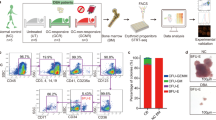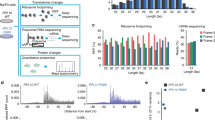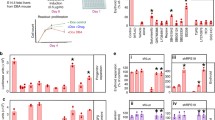Abstract
Ribosomal protein haploinsufficiency occurs in diverse human diseases including Diamond-Blackfan anemia (DBA)1,2, congenital asplenia3 and T cell leukemia4. Yet, how mutations in genes encoding ubiquitously expressed proteins such as these result in cell-type– and tissue-specific defects remains unknown5. Here, we identify mutations in GATA1, encoding the critical hematopoietic transcription factor GATA-binding protein-1, that reduce levels of full-length GATA1 protein and cause DBA in rare instances. We show that ribosomal protein haploinsufficiency, the more common cause of DBA, can lead to decreased GATA1 mRNA translation, possibly resulting from a higher threshold for initiation of translation of this mRNA in comparison with other mRNAs. In primary hematopoietic cells from patients with mutations in RPS19, encoding ribosomal protein S19, the amplitude of a transcriptional signature of GATA1 target genes was globally and specifically reduced, indicating that the activity, but not the mRNA level, of GATA1 is decreased in patients with DBA associated with mutations affecting ribosomal proteins. Moreover, the defective hematopoiesis observed in patients with DBA associated with ribosomal protein haploinsufficiency could be partially overcome by increasing GATA1 protein levels. Our results provide a paradigm by which selective defects in translation due to mutations affecting ubiquitous ribosomal proteins can result in human disease.
This is a preview of subscription content, access via your institution
Access options
Subscribe to this journal
Receive 12 print issues and online access
$209.00 per year
only $17.42 per issue
Buy this article
- Purchase on Springer Link
- Instant access to full article PDF
Prices may be subject to local taxes which are calculated during checkout




Similar content being viewed by others
References
Gazda, H.T. et al. Frameshift mutation in p53 regulator RPL26 is associated with multiple physical abnormalities and a specific pre-ribosomal RNA processing defect in diamond-blackfan anemia. Hum. Mutat. 33, 1037–1044 (2012).
Lipton, J.M. & Ellis, S.R. Diamond-Blackfan anemia: diagnosis, treatment, and molecular pathogenesis. Hematol. Oncol. Clin. North Am. 23, 261–282 (2009).
Bolze, A. et al. Ribosomal protein SA haploinsufficiency in humans with isolated congenital asplenia. Science 340, 976–978 (2013).
De Keersmaecker, K. et al. Exome sequencing identifies mutation in CNOT3 and ribosomal genes RPL5 and RPL10 in T-cell acute lymphoblastic leukemia. Nat. Genet. 45, 186–190 (2013).
Xue, S. & Barna, M. Specialized ribosomes: a new frontier in gene regulation and organismal biology. Nat. Rev. Mol. Cell Biol. 13, 355–369 (2012).
Nathan, D.G., Clarke, B.J., Hillman, D.G., Alter, B.P. & Housman, D.E. Erythroid precursors in congenital hypoplastic (Diamond-Blackfan) anemia. J. Clin. Invest. 61, 489–498 (1978).
Weiss, M.J., Mason, P.J. & Bessler, M. What's in a name? J. Clin. Invest. 122, 2346–2349 (2012).
Horos, R. et al. Ribosomal deficiencies in Diamond-Blackfan anemia impair translation of transcripts essential for differentiation of murine and human erythroblasts. Blood 119, 262–272 (2012).
Torihara, H. et al. Erythropoiesis failure due to RPS19 deficiency is independent of an activated Tp53 response in a zebrafish model of Diamond-Blackfan anaemia. Br. J. Haematol. 152, 648–654 (2011).
Jaako, P. et al. Mice with ribosomal protein S19 deficiency develop bone marrow failure and symptoms like patients with Diamond-Blackfan anemia. Blood 118, 6087–6096 (2011).
Sankaran, V.G. et al. Exome sequencing identifies GATA1 mutations resulting in Diamond-Blackfan anemia. J. Clin. Invest. 122, 2439–2443 (2012).
Orkin, S.H. & Zon, L.I. Hematopoiesis: an evolving paradigm for stem cell biology. Cell 132, 631–644 (2008).
Wechsler, J. et al. Acquired mutations in GATA1 in the megakaryoblastic leukemia of Down syndrome. Nat. Genet. 32, 148–152 (2002).
Peabody, D.S. Translation initiation at an ACG triplet in mammalian cells. J. Biol. Chem. 262, 11847–11851 (1987).
Dutt, S. et al. Haploinsufficiency for ribosomal protein genes causes selective activation of p53 in human erythroid progenitor cells. Blood 117, 2567–2576 (2011).
Flygare, J. et al. Deficiency of ribosomal protein S19 in CD34+ cells generated by siRNA blocks erythroid development and mimics defects seen in Diamond-Blackfan anemia. Blood 105, 4627–4634 (2005).
Sankaran, V.G. et al. MicroRNA-15a and -16–1 act via MYB to elevate fetal hemoglobin expression in human trisomy 13. Proc. Natl. Acad. Sci. USA 108, 1519–1524 (2011).
Rousseau, D., Kaspar, R., Rosenwald, I., Gehrke, L. & Sonenberg, N. Translation initiation of ornithine decarboxylase and nucleocytoplasmic transport of cyclin D1 mRNA are increased in cells overexpressing eukaryotic initiation factor 4E. Proc. Natl. Acad. Sci. USA 93, 1065–1070 (1996).
Kondrashov, N. et al. Ribosome-mediated specificity in Hox mRNA translation and vertebrate tissue patterning. Cell 145, 383–397 (2011).
Dieterich, D.C., Link, A.J., Graumann, J., Tirrell, D.A. & Schuman, E.M. Selective identification of newly synthesized proteins in mammalian cells using bioorthogonal noncanonical amino acid tagging (BONCAT). Proc. Natl. Acad. Sci. USA 103, 9482–9487 (2006).
Cmejlova, J. et al. Translational efficiency in patients with Diamond-Blackfan anemia. Haematologica 91, 1456–1464 (2006).
Garçon, L. et al. Ribosomal and hematopoietic defects in induced pluripotent stem cells derived from Diamond Blackfan anemia patients. Blood 122, 912–921 (2013).
Shah, P., Ding, Y., Niemczyk, M., Kudla, G. & Plotkin, J.B. Rate-limiting steps in yeast protein translation. Cell 153, 1589–1601 (2013).
Sonenberg, N., Hershey, J.W.B. & Mathews, M. Translational Control of Gene Expression (Cold Spring Harbor Laboratory Press, Cold Spring Harbor, New York, USA, 2000).
Moerke, N.J. et al. Small-molecule inhibition of the interaction between the translation initiation factors eIF4E and eIF4G. Cell 128, 257–267 (2007).
Santini, E. et al. Exaggerated translation causes synaptic and behavioural aberrations associated with autism. Nature 493, 411–415 (2013).
Gkogkas, C.G. et al. Autism-related deficits via dysregulated eIF4E-dependent translational control. Nature 493, 371–377 (2013).
Gebauer, F. & Hentze, M.W. Molecular mechanisms of translational control. Nat. Rev. Mol. Cell Biol. 5, 827–835 (2004).
Babendure, J.R., Babendure, J.L., Ding, J.H. & Tsien, R.Y. Control of mammalian translation by mRNA structure near caps. RNA 12, 851–861 (2006).
Kozak, M. An analysis of vertebrate mRNA sequences: intimations of translational control. J. Cell Biol. 115, 887–903 (1991).
Kobayashi, E., Shimizu, R., Kikuchi, Y., Takahashi, S. & Yamamoto, M. Loss of the Gata1 gene IE exon leads to variant transcript expression and the production of a GATA1 protein lacking the N-terminal domain. J. Biol. Chem. 285, 773–783 (2010).
Gazda, H.T. et al. Defective ribosomal protein gene expression alters transcription, translation, apoptosis, and oncogenic pathways in Diamond-Blackfan anemia. Stem Cells 24, 2034–2044 (2006).
Lansdorp, P.M. & Dragowska, W. Long-term erythropoiesis from constant numbers of CD34+ cells in serum-free cultures initiated with highly purified progenitor cells from human bone marrow. J. Exp. Med. 175, 1501–1509 (1992).
Subramanian, A. et al. Gene set enrichment analysis: a knowledge-based approach for interpreting genome-wide expression profiles. Proc. Natl. Acad. Sci. USA 102, 15545–15550 (2005).
Ebert, B.L. et al. Identification of RPS14 as a 5q– syndrome gene by RNA interference screen. Nature 451, 335–339 (2008).
Hu, J. et al. Isolation and functional characterization of human erythroblasts at distinct stages: implications for understanding of normal and disordered erythropoiesis in vivo. Blood 121, 3246–3253 (2013).
Moniz, H. et al. Primary hematopoietic cells from DBA patients with mutations in RPL11 and RPS19 genes exhibit distinct erythroid phenotype in vitro. Cell Death Dis. 3, e356 (2012).
Trainor, C.D., Mas, C., Archambault, P., Di Lello, P. & Omichinski, J.G. GATA-1 associates with and inhibits p53. Blood 114, 165–173 (2009).
Chylicki, K. et al. p53-mediated differentiation of the erythroleukemia cell line K562. Cell Growth Differ. 11, 315–324 (2000).
Lodish, H.F. Model for the regulation of mRNA translation applied to haemoglobin synthesis. Nature 251, 385–388 (1974).
Sankaran, V.G. et al. Human fetal hemoglobin expression is regulated by the developmental stage-specific repressor BCL11A. Science 322, 1839–1842 (2008).
Welch, J.J. et al. Global regulation of erythroid gene expression by transcription factor GATA-1. Blood 104, 3136–3147 (2004).
Matys, V. et al. TRANSFAC and its module TRANSCompel: transcriptional gene regulation in eukaryotes. Nucleic Acids Res. 34, D108–D110 (2006).
Acknowledgements
We are grateful to the patients with DBA and their families for their inspiration and encouragement. We thank A. Wakabayashi and J. Ulirsch for valuable assistance and D.G. Nathan, S.H. Orkin, D.A. Williams, S.T. Chou, G.W. Bell, C.R. Walkley, J. Flygare and D.P. Bartel for valuable comments and advice. We are grateful to L. Solomon, L. Gaffney and T. DiCesare for assistance with illustrations. This work was supported by the German National Academic Foundation (to L.S.L.), US National Institutes of Health (NIH) grants R01 HL107558 and K02 HL111156 and a grant from the DBA Foundation (to H.T.G.), NIH grant P01 HL32262 (to H.F.L.), NIH grant U54 HG003067-09 (to E.S.L.) and NIH grant R21 HL120791-01 and a March of Dimes Basil O'Connor Scholar Award (to V.G.S.).
Author information
Authors and Affiliations
Contributions
L.S.L. and V.G.S. conceived the project; L.S.L., H.T.G., J.C.E., S.W.E., R.G., A.H.B., C.A.S. and V.G.S. performed the research; L.S.L., H.T.G., P.T., H.F.L., E.S.L. and V.G.S. analyzed data; T.I.G. and J.R.G. provided clinical assessments; and L.S.L., H.F.L., E.S.L. and V.G.S. wrote the paper with input from all authors.
Corresponding author
Ethics declarations
Competing interests
The authors declare no competing financial interests.
Supplementary information
Supplementary Text and Figures
Supplementary Figures 1–20 and Supplementary Tables 1–7 (PDF 17080 kb)
Rights and permissions
About this article
Cite this article
Ludwig, L., Gazda, H., Eng, J. et al. Altered translation of GATA1 in Diamond-Blackfan anemia. Nat Med 20, 748–753 (2014). https://doi.org/10.1038/nm.3557
Received:
Accepted:
Published:
Issue Date:
DOI: https://doi.org/10.1038/nm.3557
This article is cited by
-
Perspectives of current understanding and therapeutics of Diamond-Blackfan anemia
Leukemia (2023)
-
Defects in Bone and Bone Marrow in Inherited Anemias: the Chicken or the Egg
Current Osteoporosis Reports (2023)
-
Decoding the pathogenesis of Diamond–Blackfan anemia using single-cell RNA-seq
Cell Discovery (2022)
-
Translational control of stem cell function
Nature Reviews Molecular Cell Biology (2021)
-
Small-sized extracellular vesicles (EVs) derived from acute myeloid leukemia bone marrow mesenchymal stem cells transfer miR-26a-5p to promote acute myeloid leukemia cell proliferation, migration, and invasion
Human Cell (2021)



